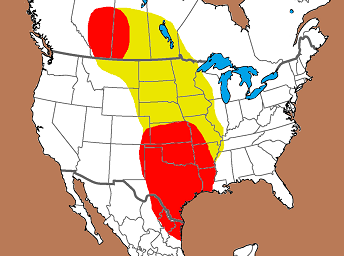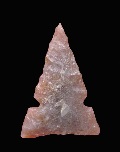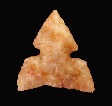Name Details:
Named By: Robert E. Bell
Named For: Washita Focus, Oklahoma
(Washita River, Oklahoma)
Date Identified: 1958
Type Site:
Washita
Cluster: Washita Cluster
Date:
Cultural Period:
800 - 400 B.P.
Mississippian
Medieval Warm to Little
Ice Age
Caddoan Culture
Glacial Period:
Culture:
Outline is Representative of Common Size and Shape:
Description of Physical Characteristics and Flaking Pattern:
This is a
thin small to point with a flattened cross section. The blade is primarily straight and may be serrated. This point
has parallel notches that generally placed higher on the blade. Then shoulders are horizontal with an expanded stem. The base may vary from straight to concave and is the widest part of
the point. This point has a random flaking pattern.
Size Measurements: Total Length - 19 to 27 mm ( 24 mm or less average), Stem Length to top of notches - 7 to 11 mm (typically 1/4
to 1/3 of the total length), Blade Width -
12 to 20 mm, Notch Depth - 2 to 3 mm, Neck
Width - 5 to 7 mm, Basal Width - 10 to 16 mm
Distribution:
Distribution Comments:
This point is primarily found in the Southern Plains region of Texas and Oklahoma and into the Central Plains. The name Plains Side Notch are more commonly used in the High
Plains, except in Alberta where the name Washita is more commonly used (see Additional Comments).

Similar Points:
Keota, Harrell, Haskell, Keota, Little Sioux, Plains, Prairie, Reed, Schustorm, Teotihuacan, Toyah Additional Comments:
The points in this cluster are similar to the points in the Woodland/Mississippian triangular cluster, except these points have side notches (Morrow, 1984). Both types of points are
noted for being thin and in the shape of an isosceles or equilateral triangle. Points in this cluster are noted for a single or multiple parallel notches in the blade. The blade may be serrated for points
in this cluster (W2).
In 1954, Dee Ann Suhm, Alex Krieger and Edward Jelks identified two sub-types of the Harrell point. One sub-type has a basal notch while the other sub-type lacked this basal notch. in 1954. In 1958, Robert Bell identified this as a separate
and unique type. He suggested that the Harrell point has a basal notch while the Washita point lacks this notch.
Justice (2002) notes that this point is similar to the many other types through-out the Desert Southwest and High Plains including points such as Desert, Cahokia, and Plains Side Notch and it's variants. This
type was named for the Washita River Culture / Washita Focus which is associated with Oklahoma and Texas. Justice points out that this type is primarily associated with the southern and central plains.
Similar points in the Cahokia Cultural region use the Cahokia Side Notch and similar points in the High Plains use the name Plains Side Notch and it's variants. This name is commonly used in
literature to describe points from Alberta Canada and the surrounding region. In Canada, points that use this name are limited to small side notched points with a narrow parallel notch high on the blade and a
base that expands or flares out from the notch to the basal corners with a straight base. This point was originally considered a sub-type of the Harrell point and probably has the same distribution of the
Harrell point, and the associated Washita Peno variant (Washita point with a concave base).
Point Validity: Valid Type
Bell was a professor of
anthropology and Museum Curator in Oklahoma and did extensive work at the Spiro Mounds. He named this point in a professional publication and this point has many
professional references. This is a valid type.
.
Age Details:
References: (See Reference Page, Entry Number):
8,
12,
23,
30, 177, 182, W2
Washita Projectile Point, Washita Arrowhead












